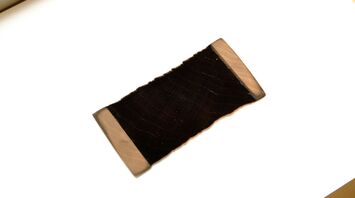UBC discovered light-absorbing black wood: it can improve optical devices

Super-black wood, a new material developed by researchers at the University of British Columbia, has the potential to revolutionize various industries such as telescopes, optical devices, and consumer goods, reports ScienceDaily. This accidental discovery has led to the creation of a sustainable material that absorbs almost all light, offering numerous applications in different fields.
The discovery came about during experiments by Professor Philip Evans and PhD student Kenny Cheng, who were initially attempting to make wood more water-repellent using high-energy plasma. However, when this technique was applied to the cut ends of wood cells, the surfaces became incredibly black. Further measurements by Texas A&M University's department of physics and astronomy confirmed that the material absorbed less than one percent of visible light.
Rather than disregarding this accidental finding, the researchers shifted their focus towards designing super-black materials. This approach has provided a new avenue in the quest for the darkest materials on Earth. Dr. Evans explains that super-black materials can absorb over 99 percent of the light that strikes them, surpassing the capabilities of normal black paint which absorbs approximately 97.5 percent of light.

The demand for super-black materials is steadily increasing in fields such as astronomy, where coatings on devices help minimize stray light and enhance image clarity. Additionally, these coatings can improve the efficiency of solar cells and are also utilized in the production of luxury consumer items like watches. The researchers have created prototype commercial products using their super-black wood, with a specific focus on watches and jewelry. They plan to explore other potential commercial applications in the future.
This extremely black material has been named Nxylon, a combination of "Nyx" (the Greek goddess of the night) and "xylon" (the Greek word for wood). What distinguishes Nxylon from other black materials is its ability to maintain its darkness even when coated with alloys or other substances. Utilizing Nxylon eliminates the dependence on black pigments as its inherent structure prevents light from escaping.

The advantages of Nxylon, developed from basswood and other readily available types of wood like European lime wood, are abundant. It is lightweight, stiff, and easy to be shaped into intricate designs. In terms of commercial expansion, the researchers plan to establish Nxylon Corporation of Canada and collaborate with jewelers, artists, and tech product designers to scale up the applications of Nxylon. They also aim to construct a commercial-scale plasma reactor capable of producing larger super-black wood samples suitable for non-reflective ceiling and wall tiles.
Significantly, Nxylon's development showcases the untapped potential of the wood industry. Dr. Evans notes that Nxylon can be made from sustainable and widely available materials found in North America and Europe, breathing new life into the forestry sector. Through this remarkable discovery, super-black wood could transform various industries while being environmentally conscious and versatile.
Earlier SSP reported that NASA and JAXA achieve laser communication between moon's surface and lunar orbit.



















